
Illustrative Math Alignment: Grade 7 Unit 8
Probability and Sampling
Lesson 5: More Estimating Probabilities
Use the following Media4Math resources with this Illustrative Math lesson.
| Thumbnail Image | Title | Body | Curriculum Topic |
|---|---|---|---|
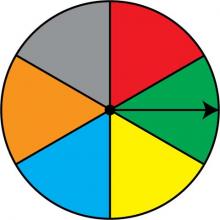
|
Math Clip Art: Spinner, 6 Sections--Result 2 | Math Clip Art: Spinner, 6 Sections--Result 2TopicProbability and Statistics DescriptionThis image displays a spinner divided into six equal sections: yellow, blue, orange, grey, red, and green. The spinner's arrow currently points to the green section, indicating one of the six possible outcomes. In Probability and Statistics, this spinner serves as a vivid example of an experiment with multiple equally likely outcomes. Each section of the spinner represents a 1/6 probability, making it a useful tool for teaching the concept of equally probable events. |
Probability |
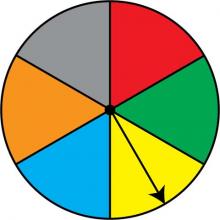
|
Math Clip Art: Spinner, 6 Sections--Result 3 | Math Clip Art: Spinner, 6 Sections--Result 3TopicProbability and Statistics DescriptionThis image displays a spinner divided into six equal sections: yellow, blue, orange, grey, red, and green. The spinner's arrow currently points to the yellow section, indicating one of the six possible outcomes. In Probability and Statistics, this spinner serves as a vivid example of an experiment with multiple equally likely outcomes. Each section of the spinner represents a 1/6 probability, making it a useful tool for teaching the concept of equally probable events. |
Probability |
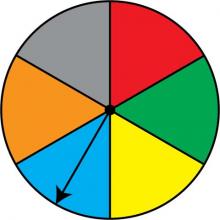
|
Math Clip Art: Spinner, 6 Sections--Result 4 | Math Clip Art: Spinner, 6 Sections--Result 4TopicProbability and Statistics DescriptionThis image displays a spinner divided into six equal sections: yellow, blue, orange, grey, red, and green. The spinner's arrow currently points to the blue section, indicating one of the six possible outcomes. In Probability and Statistics, this spinner serves as a vivid example of an experiment with multiple equally likely outcomes. Each section of the spinner represents a 1/6 probability, making it a useful tool for teaching the concept of equally probable events. |
Probability |

|
Math Clip Art: Spinner, 6 Sections--Result 5 | Math Clip Art: Spinner, 6 Sections--Result 5TopicProbability and Statistics DescriptionThis image displays a spinner divided into six equal sections: yellow, blue, orange, grey, red, and green. The spinner's arrow currently points to the orange section, indicating one of the six possible outcomes. In Probability and Statistics, this spinner serves as a vivid example of an experiment with multiple equally likely outcomes. Each section of the spinner represents a 1/6 probability, making it a useful tool for teaching the concept of equally probable events. |
Probability |
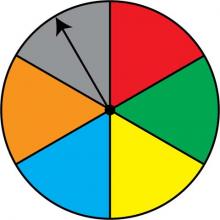
|
Math Clip Art: Spinner, 6 Sections--Result 6 | Math Clip Art: Spinner, 6 Sections--Result 6TopicProbability and Statistics DescriptionThis image displays a spinner divided into six equal sections: yellow, blue, orange, grey, red, and green. The spinner's arrow currently points to the grey section, indicating one of the six possible outcomes. In Probability and Statistics, this spinner serves as a vivid example of an experiment with multiple equally likely outcomes. Each section of the spinner represents a 1/6 probability, making it a useful tool for teaching the concept of equally probable events. |
Probability |
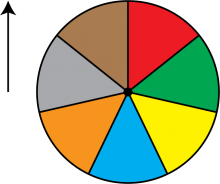
|
Math Clip Art: Spinner, 7 Sections | Math Clip Art: Spinner, 8 SectionsTopicProbability and Statistics DescriptionThis image depicts a spinner divided into eight equal sections, with an arrow provided for spinning. This template can be used to create a physical spinner for exploring advanced probability concepts and more complex experimental designs. In Probability and Statistics, this eight-section spinner represents a sophisticated probability model with eight equally likely outcomes. Each section has a 1/8 probability, allowing for the exploration of intricate probability scenarios, compound events, and the introduction of more advanced statistical concepts. |
Probability |
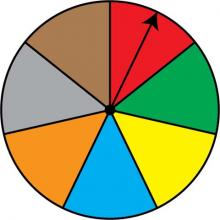
|
Math Clip Art: Spinner, 7 Sections--Result 1 | Math Clip Art: Spinner, 7 Sections--Result 1TopicProbability and Statistics DescriptionThis image showcases a spinner divided into seven equal sections colored red, green, yellow, blue, orange, grey, and brown. The spinner's arrow points to the red section, illustrating one of the seven possible outcomes. In the context of Probability and Statistics, this spinner represents a more complex probability model with seven equally likely outcomes. Each section has a probability of 1/7, demonstrating how probability changes as the number of possible outcomes increases. |
Probability |
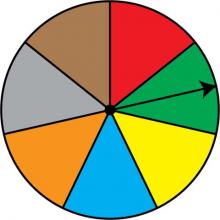
|
Math Clip Art: Spinner, 7 Sections--Result 2 | Math Clip Art: Spinner, 7 Sections--Result 2TopicProbability and Statistics DescriptionThis image presents a spinner divided into seven equal sections colored red, green, yellow, blue, orange, grey, and brown. The spinner's arrow points to the green section, showcasing another possible outcome in this probability model. In Probability and Statistics, this spinner illustrates a fair probability experiment with seven mutually exclusive and equally likely outcomes. It provides a visual representation of how each spin has an equal 1/7 chance of landing on any of the seven colors. |
Probability |
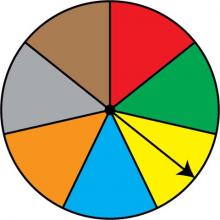
|
Math Clip Art: Spinner, 7 Sections--Result 3 | Math Clip Art: Spinner, 7 Sections--Result 3TopicProbability and Statistics DescriptionThis image displays a spinner divided into seven equal sections colored red, green, yellow, blue, orange, grey, and brown. The spinner's arrow points to the yellow section, demonstrating the third possible outcome in this probability model. In the field of Probability and Statistics, this spinner exemplifies a uniform probability distribution with seven equally likely outcomes. Each spin has a 1/7 probability of landing on any given color, illustrating the concept of equiprobable events in a more complex scenario. |
Probability |
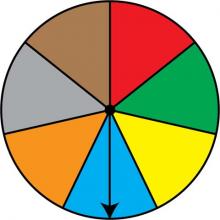
|
Math Clip Art: Spinner, 7 Sections--Result 4 | Math Clip Art: Spinner, 7 Sections--Result 4TopicProbability and Statistics DescriptionThis image features a spinner divided into seven equal segments colored red, green, yellow, blue, orange, grey, and brown. The spinner's arrow points to the blue section, depicting the fourth possible outcome in this probability model. In Probability and Statistics, this spinner serves as a vivid example of an experiment with multiple equally likely outcomes. Each section of the spinner represents a 1/7 probability, making it a useful tool for teaching the concept of equally probable events in more complex scenarios. |
Probability |
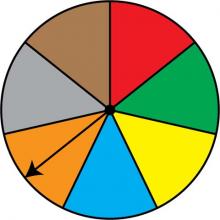
|
Math Clip Art: Spinner, 7 Sections--Result 5 | Math Clip Art: Spinner, 7 Sections--Result 5TopicProbability and Statistics DescriptionThis image presents a spinner divided into seven equal sections colored red, green, yellow, blue, orange, grey, and brown. The spinner's arrow points to the orange section, illustrating the fifth possible outcome in this probability model. In the realm of Probability and Statistics, this spinner exemplifies a uniform probability distribution with seven equally likely outcomes. Each spin has a 1/7 probability of landing on any given color, demonstrating how probability concepts apply in scenarios with multiple outcomes. |
Probability |

|
Math Clip Art: Spinner, 7 Sections--Result 6 | Math Clip Art: Spinner, 7 Sections--Result 6TopicProbability and Statistics DescriptionThis image showcases a spinner divided into seven equal sections colored red, green, yellow, blue, orange, grey, and brown. The spinner's arrow points to the grey section, demonstrating the sixth possible outcome in this probability model. In the context of Probability and Statistics, this spinner represents a more complex probability experiment with seven equally likely outcomes. It visually demonstrates the concepts of sample space and individual events within that space, each with a 1/7 probability of occurrence. |
Probability |
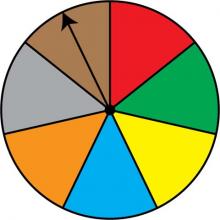
|
Math Clip Art: Spinner, 7 Sections--Result 7 | Math Clip Art: Spinner, 7 Sections--Result 7TopicProbability and Statistics DescriptionThis image depicts a spinner divided into seven equal sections colored red, green, yellow, blue, orange, grey, and brown. The spinner's arrow points to the brown section, showcasing the final possible outcome in this probability model. In Probability and Statistics, this spinner illustrates a fair probability experiment with seven mutually exclusive and equally likely outcomes. It provides a visual representation of how each spin has an equal 1/7 chance of landing on any of the seven colors, demonstrating complex probability scenarios. |
Probability |
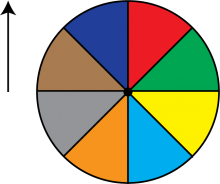
|
Math Clip Art: Spinner, 8 Sections | Math Clip Art: Spinner, 9 SectionsTopicProbability and Statistics DescriptionThis image presents a spinner divided into nine equal sections, accompanied by an arrow for spinning. This template can be used to create a physical spinner for exploring highly complex probability concepts and sophisticated experimental designs. In the realm of Probability and Statistics, this nine-section spinner exemplifies an advanced probability model with nine equally likely outcomes. Each section has a 1/9 probability, enabling the study of intricate probability scenarios, compound events, and the application of advanced statistical concepts. |
Probability |
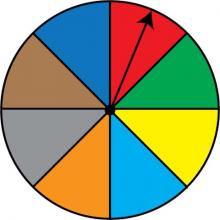
|
Math Clip Art: Spinner, 8 Sections--Result 1 | Math Clip Art: Spinner, 8 Sections--Result 1TopicProbability and Statistics DescriptionThis image features a spinner divided into eight equal sections colored red, green, yellow, light blue, orange, grey, brown, and dark blue. The spinner's arrow points to the red section, demonstrating one of the possible outcomes. In the realm of Probability and Statistics, this spinner illustrates how the sample space expands with more outcomes, each having an equal probability of 1/8. It serves as an excellent tool for teaching about equiprobable events in complex scenarios. |
Probability |
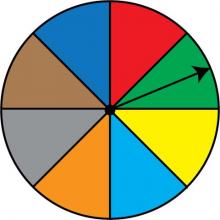
|
Math Clip Art: Spinner, 8 Sections--Result 2 | Math Clip Art: Spinner, 8 Sections--Result 2TopicProbability and Statistics DescriptionThis image features a spinner divided into eight equal sections colored red, green, yellow, light blue, orange, grey, brown, and dark blue. The spinner's arrow points to the green section, demonstrating one of the possible outcomes. In the realm of Probability and Statistics, this spinner illustrates how the sample space expands with more outcomes, each having an equal probability of 1/8. It serves as an excellent tool for teaching about equiprobable events in complex scenarios. |
Probability |
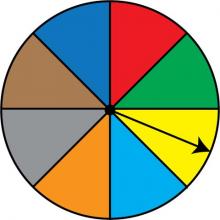
|
Math Clip Art: Spinner, 8 Sections--Result 3 | Math Clip Art: Spinner, 8 Sections--Result 3TopicProbability and Statistics DescriptionThis image features a spinner divided into eight equal sections colored red, green, yellow, light blue, orange, grey, brown, and dark blue. The spinner's arrow points to the yellow section, demonstrating one of the possible outcomes. In the realm of Probability and Statistics, this spinner illustrates how the sample space expands with more outcomes, each having an equal probability of 1/8. It serves as an excellent tool for teaching about equiprobable events in complex scenarios. |
Probability |

|
Math Clip Art: Spinner, 8 Sections--Result 4 | Math Clip Art: Spinner, 8 Sections--Result 4TopicProbability and Statistics DescriptionThis image features a spinner divided into eight equal sections colored red, green, yellow, light blue, orange, grey, brown, and dark blue. The spinner's arrow points to the light blue section, demonstrating one of the possible outcomes. In the realm of Probability and Statistics, this spinner illustrates how the sample space expands with more outcomes, each having an equal probability of 1/8. It serves as an excellent tool for teaching about equiprobable events in complex scenarios. |
Probability |
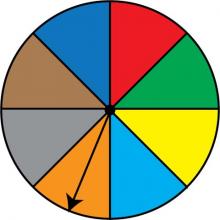
|
Math Clip Art: Spinner, 8 Sections--Result 5 | Math Clip Art: Spinner, 8 Sections--Result 5TopicProbability and Statistics DescriptionThis image features a spinner divided into eight equal sections colored red, green, yellow, light blue, orange, grey, brown, and dark blue. The spinner's arrow points to the orange section, demonstrating one of the possible outcomes. In the realm of Probability and Statistics, this spinner illustrates how the sample space expands with more outcomes, each having an equal probability of 1/8. It serves as an excellent tool for teaching about equiprobable events in complex scenarios. |
Probability |
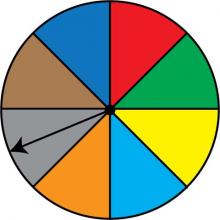
|
Math Clip Art: Spinner, 8 Sections--Result 6 | Math Clip Art: Spinner, 8 Sections--Result 6TopicProbability and Statistics DescriptionThis image features a spinner divided into eight equal sections colored red, green, yellow, light blue, orange, grey, brown, and dark blue. The spinner's arrow points to the grey section, demonstrating one of the possible outcomes. In the realm of Probability and Statistics, this spinner illustrates how the sample space expands with more outcomes, each having an equal probability of 1/8. It serves as an excellent tool for teaching about equiprobable events in complex scenarios. |
Probability |

|
Math Clip Art: Spinner, 8 Sections--Result 7 | Math Clip Art: Spinner, 8 Sections--Result 7TopicProbability and Statistics DescriptionThis image features a spinner divided into eight equal sections colored red, green, yellow, light blue, orange, grey, brown, and dark blue. The spinner's arrow points to the brown section, demonstrating one of the possible outcomes. In the realm of Probability and Statistics, this spinner illustrates how the sample space expands with more outcomes, each having an equal probability of 1/8. It serves as an excellent tool for teaching about equiprobable events in complex scenarios. |
Probability |
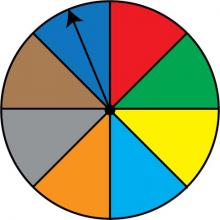
|
Math Clip Art: Spinner, 8 Sections--Result 8 | Math Clip Art: Spinner, 8 Sections--Result 8TopicProbability and Statistics DescriptionThis image features a spinner divided into eight equal sections colored red, green, yellow, light blue, orange, grey, brown, and dark blue. The spinner's arrow points to the dark blue section, demonstrating one of the possible outcomes. In the realm of Probability and Statistics, this spinner illustrates how the sample space expands with more outcomes, each having an equal probability of 1/8. It serves as an excellent tool for teaching about equiprobable events in complex scenarios. |
Probability |
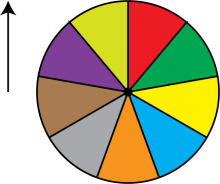
|
Math Clip Art: Spinner, 9 Sections | Math Clip Art: Spinner, 9 SectionsTopicProbability and Statistics DescriptionThis image presents a spinner divided into nine equal sections, accompanied by an arrow for spinning. This template can be used to create a physical spinner for exploring highly complex probability concepts and sophisticated experimental designs. In the realm of Probability and Statistics, this nine-section spinner exemplifies an advanced probability model with nine equally likely outcomes. Each section has a 1/9 probability, enabling the study of intricate probability scenarios, compound events, and the application of advanced statistical concepts. |
Probability |
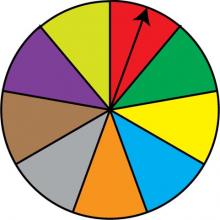
|
Math Clip Art: Spinner, 9 Sections--Result 1 | Math Clip Art: Spinner, 9 Sections--Result 1TopicProbability and Statistics DescriptionThis image features a spinner divided into nine equal sections colored red, green, dark yellow, light blue, orange, grey, brown, purple, and light yellow. The spinner's arrow points to the red section, demonstrating one of the nine possible outcomes. In the realm of Probability and Statistics, this spinner illustrates how the sample space expands with more outcomes, each having an equal probability of 1/9. It serves as an excellent tool for teaching about equiprobable events in complex scenarios. |
Probability |
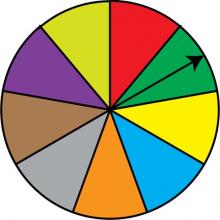
|
Math Clip Art: Spinner, 9 Sections--Result 2 | Math Clip Art: Spinner, 9 Sections--Result 2TopicProbability and Statistics DescriptionThis image showcases a spinner divided into nine equal sections colored red, green, dark yellow, light blue, orange, grey, brown, purple, and light yellow. The spinner's arrow points to the green section, illustrating another possible outcome. In Probability and Statistics, this spinner represents a fair probability experiment with nine mutually exclusive and equally likely outcomes. It provides a visual representation of how each spin has an equal 1/9 chance of landing on any of the nine colors. |
Probability |

|
Math Clip Art: Spinner, 9 Sections--Result 3 | Math Clip Art: Spinner, 9 Sections--Result 3TopicProbability and Statistics DescriptionThis image displays a spinner divided into nine equal sections colored red, green, dark yellow, light blue, orange, grey, brown, purple, and light yellow. The spinner's arrow points to the dark yellow section, showcasing another possible outcome in this probability model. In the field of Probability and Statistics, this spinner exemplifies a uniform probability distribution with nine equally likely outcomes. Each spin has a 1/9 probability of landing on any given color, illustrating the concept of equiprobable events in a more complex scenario. |
Probability |
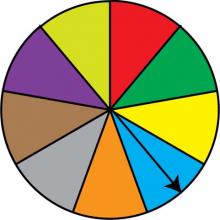
|
Math Clip Art: Spinner, 9 Sections--Result 4 | Math Clip Art: Spinner, 9 Sections--Result 4TopicProbability and Statistics DescriptionThis image presents a spinner divided into nine equal sections colored red, green, dark yellow, light blue, orange, grey, brown, purple, and light yellow. The spinner's arrow points to the light blue section, demonstrating another possible outcome in this probability model. In Probability and Statistics, this spinner illustrates a fair probability experiment with nine mutually exclusive and equally likely outcomes. It provides a visual representation of how each spin has an equal 1/9 chance of landing on any of the nine colors. |
Probability |
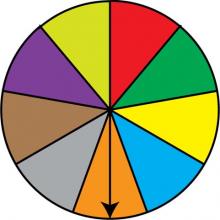
|
Math Clip Art: Spinner, 9 Sections--Result 5 | Math Clip Art: Spinner, 9 Sections--Result 5TopicProbability and Statistics DescriptionThis image showcases a spinner divided into nine equal sections colored red, green, dark yellow, light blue, orange, grey, brown, purple, and light yellow. The spinner's arrow points to the orange section, illustrating another possible outcome in this probability model. In the context of Probability and Statistics, this spinner represents a probability experiment with nine equally likely outcomes. It visually demonstrates the concepts of sample space and individual events within that space, each with a 1/9 probability of occurrence. |
Probability |
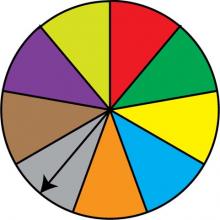
|
Math Clip Art: Spinner, 9 Sections--Result 6 | Math Clip Art: Spinner, 9 Sections--Result 6TopicProbability and Statistics DescriptionThis image displays a spinner divided into nine equal sections colored red, green, dark yellow, light blue, orange, grey, brown, purple, and light yellow. The spinner's arrow points to the grey section, showcasing another possible outcome in this probability model. In the field of Probability and Statistics, this spinner exemplifies a uniform probability distribution with nine equally likely outcomes. Each spin has a 1/9 probability of landing on any given color, illustrating the concept of equiprobable events in a more complex scenario. |
Probability |
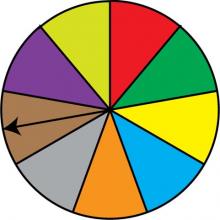
|
Math Clip Art: Spinner, 9 Sections--Result 7 | Math Clip Art: Spinner, 9 Sections--Result 7TopicProbability and Statistics DescriptionThis image presents a spinner divided into nine equal sections colored red, green, dark yellow, light blue, orange, grey, brown, purple, and light yellow. The spinner's arrow points to the brown section, demonstrating another possible outcome in this probability model. In Probability and Statistics, this spinner illustrates a fair probability experiment with nine mutually exclusive and equally likely outcomes. It provides a visual representation of how each spin has an equal 1/9 chance of landing on any of the nine colors. |
Probability |

|
Math Clip Art: Spinner, 9 Sections--Result 8 | Math Clip Art: Spinner, 9 Sections--Result 8TopicProbability and Statistics DescriptionThis image showcases a spinner divided into nine equal sections colored red, green, dark yellow, light blue, orange, grey, brown, purple, and light yellow. The spinner's arrow points to the purple section, illustrating another possible outcome in this probability model. In the context of Probability and Statistics, this spinner represents a probability experiment with nine equally likely outcomes. It visually demonstrates the concepts of sample space and individual events within that space, each with a 1/9 probability of occurrence. |
Probability |
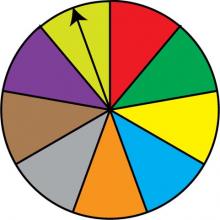
|
Math Clip Art: Spinner, 9 Sections--Result 9 | Math Clip Art: Spinner, 9 Sections--Result 9TopicProbability and Statistics DescriptionThis image displays a spinner divided into nine equal sections colored red, green, dark yellow, light blue, orange, grey, brown, purple, and light yellow. The spinner's arrow points to the light yellow section, showcasing the final possible outcome in this probability model. In the field of Probability and Statistics, this spinner exemplifies a uniform probability distribution with nine equally likely outcomes. Each spin has a 1/9 probability of landing on any given color, illustrating the concept of equiprobable events in a more complex scenario. |
Probability |
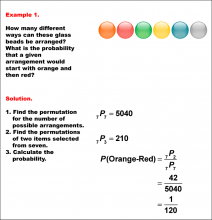
|
Math Example--Probability Concepts--Probabilities Involving Permutations and Combinations--Example 1 | Math Example--Probability Concepts--Probabilities Involving Permutations and Combinations--Example 1
This is part of a collection of math examples that explore different aspects of probability. |
Probability |
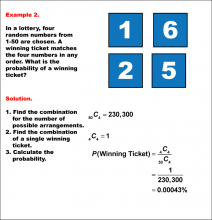
|
Math Example--Probability Concepts--Probabilities Involving Permutations and Combinations--Example 2 | Math Example--Probability Concepts--Probabilities Involving Permutations and Combinations--Example 2
This is part of a collection of math examples that explore different aspects of probability. |
Probability |
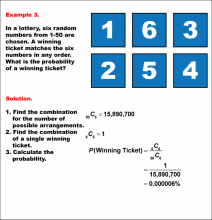
|
Math Example--Probability Concepts--Probabilities Involving Permutations and Combinations--Example 3 | Math Example--Probability Concepts--Probabilities Involving Permutations and Combinations--Example 3
This is part of a collection of math examples that explore different aspects of probability. |
Probability |
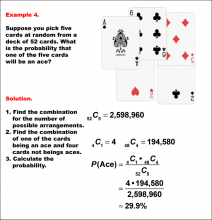
|
Math Example--Probability Concepts--Probabilities Involving Permutations and Combinations--Example 4 | Math Example--Probability Concepts--Probabilities Involving Permutations and Combinations--Example 4
This is part of a collection of math examples that explore different aspects of probability. |
Probability |
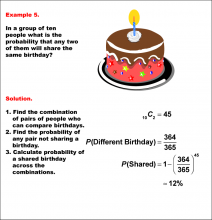
|
Math Example--Probability Concepts--Probabilities Involving Permutations and Combinations--Example 5 | Math Example--Probability Concepts--Probabilities Involving Permutations and Combinations--Example 5
This is part of a collection of math examples that explore different aspects of probability. |
Probability |

|
Math Example--Probability Concepts--Probabilities Involving Permutations and Combinations--Example 6 | Math Example--Probability Concepts--Probabilities Involving Permutations and Combinations--Example 6
This is part of a collection of math examples that explore different aspects of probability. |
Probability |
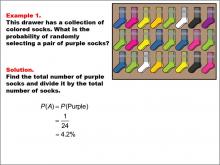
|
Math Example--Probability Concepts--Probability: Example 1 | Math Example--Probability Concepts--Probability: Example 1
This is part of a collection of math examples that explore different aspects of probability. |
Probability |
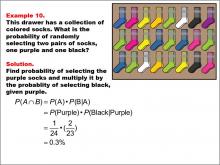
|
Math Example--Probability Concepts--Probability: Example 10 | Math Example--Probability Concepts--Probability: Example 10TopicProbability and Statistics |
Probability |
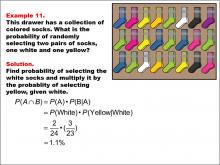
|
Math Example--Probability Concepts--Probability: Example 11 | Math Example--Probability Concepts--Probability: Example 11TopicProbability and Statistics DescriptionThis example involves a drawer filled with socks in colors like blue, pink, yellow, green, white, and black. Students calculate the probability of selecting two pairs of socks: one white and one yellow. They find the probability of selecting white socks first and then multiply it by the probability of selecting yellow socks given that white has already been selected. This exercise introduces conditional probabilities, reinforcing key concepts while providing practical application. Visual aids help students understand these calculations. |
Probability |
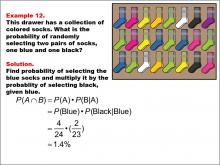
|
Math Example--Probability Concepts--Probability: Example 12 | Math Example--Probability Concepts--Probability: Example 12TopicProbability and Statistics DescriptionThis example presents a drawer with socks in colors like blue, pink, yellow, green, white, and black. Students calculate the probability of selecting two pairs of socks: one blue and one black. They determine the probability of selecting blue socks first and then multiply it by the probability of selecting black socks given that blue has already been selected. This scenario reinforces conditional probabilities and helps students apply these concepts in real-world contexts. |
Probability |
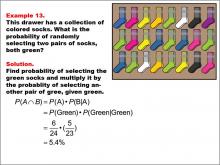
|
Math Example--Probability Concepts--Probability: Example 13 | Math Example--Probability Concepts--Probability: Example 13TopicProbability and Statistics DescriptionThis example features a drawer with colored socks including blue, pink, yellow, green, white, black, and purple. Students calculate the probability of selecting two green socks. They find the probability of selecting green socks first and then multiply it by the probability of selecting another pair given that green has already been selected. This exercise emphasizes conditional probabilities and enhances understanding through visual aids. |
Probability |
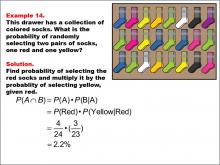
|
Math Example--Probability Concepts--Probability: Example 14 | Math Example--Probability Concepts--Probability: Example 14TopicProbability and Statistics DescriptionThis example shows a drawer with colored socks including blue, pink, yellow, green, white, black, and purple. Students calculate the probability of selecting one red sock and one yellow sock. They determine the probability of selecting red first and then multiply it by the probability of selecting yellow given red. This problem reinforces conditional probabilities using visual aids to clarify solutions. |
Probability |
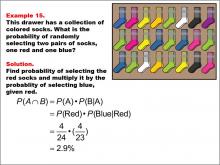
|
Math Example--Probability Concepts--Probability: Example 15 | Math Example--Probability Concepts--Probability: Example 15TopicProbability and Statistics DescriptionThis example involves a drawer with colored socks including blue, pink, yellow, green, white, black, and purple. Students calculate the probability of selecting one red sock and one blue sock. They find the probability of selecting red first and multiply it by the probability of selecting blue given red. This scenario uses conditional probabilities to reinforce learning through visual aids. |
Probability |

|
Math Example--Probability Concepts--Probability: Example 16 | Math Example--Probability Concepts--Probability: Example 16TopicProbability and Statistics DescriptionThis example displays a drawer with colored socks including blue, pink, yellow, green, white, black, and purple. Students calculate the probability of selecting one green pair and one yellow pair. They determine the probability of selecting green first and multiply it by the probability of selecting yellow given green. This exercise emphasizes conditional probabilities using visual aids to enhance understanding. |
Probability |

|
Math Example--Probability Concepts--Probability: Example 17 | Math Example--Probability Concepts--Probability: Example 17TopicProbability and Statistics DescriptionThis example features a drawer with colored socks including blue, pink, yellow, green, white, black, and purple. Students calculate the probability of selecting one green sock and one blue sock. They find the probability of selecting green first and multiply it by the probability of selecting blue given green. Visual aids support understanding as students apply conditional probabilities. For a complete collection of math examples related to Probability click on this link: Math Examples: Probability Collection. |
Probability |
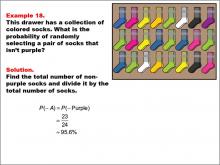
|
Math Example--Probability Concepts--Probability: Example 18 | Math Example--Probability Concepts--Probability: Example 18TopicProbability and Statistics DescriptionThis example presents a drawer with colored socks including blue, pink, yellow, green, white, black, and purple. Students calculate the probability of not selecting purple socks by finding non-purple totals divided by overall totals. This exercise reinforces basic principles while using visual aids for clarity in solving problems involving non-desired outcomes. For a complete collection of math examples related to Probability click on this link: Math Examples: Probability Collection. |
Probability |
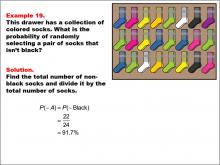
|
Math Example--Probability Concepts--Probability: Example 19 | Math Example--Probability Concepts--Probability: Example 19TopicProbability and Statistics DescriptionThis example involves a drawer filled with socks in colors such as blue, pink, green, yellow, white, and black. Students calculate the probability of selecting socks that are not black by finding the total number of non-black socks and dividing it by the total number of socks. This exercise reinforces basic probability concepts using visual aids to aid understanding. For a complete collection of math examples related to Probability click on this link: Math Examples: Probability Collection. |
Probability |
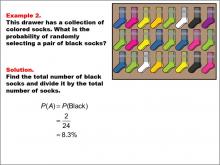
|
Math Example--Probability Concepts--Probability: Example 2 | Math Example--Probability Concepts--Probability: Example 2TopicProbability and Statistics |
Probability |